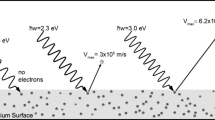Abstract
The author has recently proposed a “quasi-classical” theory of particles and interactions in which particles are pictured as extended periodic disturbances in a universal field χ(x, t), interacting with each other via nonlinearity in the equation of motion for χ. The present paper explores the relationship of this theory to nonrelativistic quantum mechanics; as a first step, it is shown how it is possible to construct from χ a configuration-space wave function Ψ(x 1,x 2,t), and that the theory requires that Ψ satisfy the two-particle Schrödinger equation in the case where the two particles are well separated from each other. This suggests that the multiparticle Schrödinger equation can be obtained as a direct consequence of the quasi-classical theory without any use of the usual formalism (Hilbert space, quantization rules, etc.) of conventional quantum theory and in particular without using the classical canonical treatment of a system as a “crutch” theory which has subsequently to be “quantized.” The quasi-classical theory also suggests the existence of a preferred “absolute” gauge for the electromagnetic potentials.
Similar content being viewed by others
References
J. W. G. Wignall,Found. Phys. 15, 207 (1985).
J. D. Bjorken and S. D. Drell,Relativistic Quantum Fields (McGraw-Hill, New York, 1965).
C. Davisson and L. H. Germer,Phys. Rev. 30, 705 (1927).
Y. Aharonov and D. Bohm,Phys. Rev. 115, 485 (1959).
R. G. Chambers,Phys. Rev. Lett. 5, 3 (1960); H. A. Fowler, L. Marton, J. A. Simpson, and J. A. Suddeth,J. Appl. Phys. 32, 1153 (1961); H. Boersch, H. Hamisch, K. Grohmann, and D. Wohlleber,Z. Phys. 165, 79 (1961); G. Möllenstedt and W. Bayh,Phys. Bl. 18, 299 (1962); G. Matteucci and G. Pozzi,Am. J. Phys. 46, 619 (1978); G. Möllenstedt, H. Schmid, and H. Lichte, inElectron Microscopy 1982, edited by the Congress Organizing Committee (10th International Congress on Electron Microscopy, Hamburg, 1982), Vol. I, p. 433; A. Tonomura, T. Matsuda, R. Suzuki, A. Fukuhara, N. Osakebe, H. Umezeki, J. Endo, K. Shinagawa, Y. Sugita, and H. Fujiwara,Phys. Rev. Lett. 48, 1443 (1982);51, 331 (1983).
J. W. G. Wignall, “Nonlocal Aspects of the Quasi-Classical Theory,” Melbourne University Preprint UM-P-84/93, 1984.
K. Gottfried,Quantum Mechanics, Vol. I (Benjamin, New York, 1966).
R. P. Feynman,Rev. Mod. Phys. 20, 367 (1948); R. P. Feynman and A. R. Hibbs,Quantum Mechanics and Path Integrals (McGraw-Hill, New York, 1965).
W. Bartelet al., Z. Phys. C19, 197 (1983); D. Benderet al., Phys. Rev. D 30, 515 (1984).
Author information
Authors and Affiliations
Rights and permissions
About this article
Cite this article
Wignall, J.W.G. The nonrelativistic Schrödinger equation in “quasi-classical” theory. Found Phys 17, 123–147 (1987). https://doi.org/10.1007/BF00733204
Received:
Issue Date:
DOI: https://doi.org/10.1007/BF00733204



